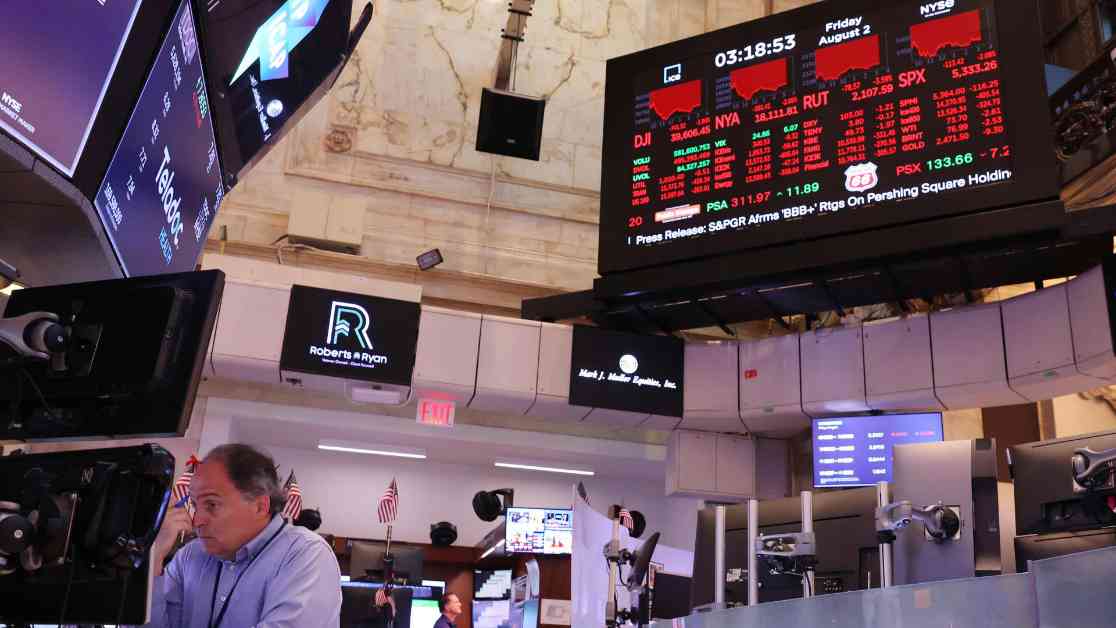Recession fears have been looming over the stock market in recent days, with the S&P 500 index experiencing a 3% loss on Monday, marking its worst performance in almost two years. The concerns were sparked by weaker-than-expected job data released on Friday, which raised doubts about the stability of the U.S. economy and the Federal Reserve’s strategy of achieving a “soft landing.”
What is a “soft landing,” you may wonder? A soft landing refers to a scenario where the Federal Reserve successfully navigates its interest-rate policy to control inflation without causing a full-blown economic downturn. It is essentially a gentle slowdown in economic growth, rather than a sudden and severe recession.
Despite the grim job data and rising unemployment rate, economists still believe that a soft landing is a plausible outcome. Mark Zandi, chief economist at Moody’s, expressed optimism, stating, “I think far and away the most likely scenario is a soft landing: The economy avoids an economic downturn.” Similarly, Jay Bryson, chief economist at Wells Fargo Economics, echoed this sentiment, affirming that a soft landing remains his “base case” forecast.
However, the possibility of a recession cannot be completely dismissed, given the signs of economic weakness that have emerged. The recent uptick in the unemployment rate has raised concerns among investors, with some fearing that a “hard landing” may be on the horizon. In order to avert a recession, Zandi and Bryson emphasized the importance of the Federal Reserve taking prompt action to lower interest rates.
The recent market turbulence was triggered by the monthly jobs report released by the Bureau of Labor Statistics, which revealed a rise in the national unemployment rate to 4.3% in July. While this rate is still relatively low by historical standards, the steady increase over the past year has activated the so-called “Sahm rule,” a recession indicator based on changes in the unemployment rate.
According to the Sahm rule, if the three-month moving average of the unemployment rate exceeds its low over the previous 12 months by half a percentage point or more, it signals that the economy may already be in a recession. The breach of this threshold in July led Goldman Sachs to raise its recession forecast to 25% from 15%, highlighting the heightened risk of an economic downturn.
Despite the concerns raised by the Sahm rule and other economic indicators, Zandi pointed out that the current labor market dynamics may not necessarily align with historical patterns. The rise in the unemployment rate can be attributed to a surge in labor supply, as more Americans entered the job market in search of employment.
Moreover, there are positive indicators that suggest the economy’s resilience amidst the challenges. Real consumer spending, adjusted for inflation, remains robust, providing a solid foundation for economic growth. Consumer spending plays a significant role in driving economic activity, and if consumers continue to spend, the economy is likely to remain stable.
In addition to consumer spending, the financial health of households is another factor that supports the economy’s overall strength. Despite some warning signs in the labor market data, underlying fundamentals indicate that households are in a relatively stable position. Furthermore, the anticipated interest rate cuts by the Federal Reserve in September are expected to alleviate financial pressures on households, particularly those with lower incomes.
While acknowledging the growing concerns about the economy’s trajectory, economists emphasize that the current situation is not comparable to past crises like the financial meltdown of 2008 or the onset of the COVID-19 pandemic in 2020. The gradual weakening of economic indicators warrants caution, but it does not signal an imminent collapse of the economy.
As the debate over a potential soft landing versus a recession continues, investors and policymakers are closely monitoring economic data for signals of the future trajectory. The impending decisions by the Federal Reserve regarding interest rates will be crucial in determining whether the economy can achieve a soft landing or faces the risk of a more severe downturn.
In conclusion, while the specter of a recession looms over the economy, economists remain cautiously optimistic about the possibility of a soft landing. The evolving economic landscape underscores the importance of proactive measures to sustain growth and mitigate risks. By staying attuned to market dynamics and responding swiftly to changing conditions, stakeholders can navigate the challenges ahead and steer the economy towards a path of stability and prosperity.














